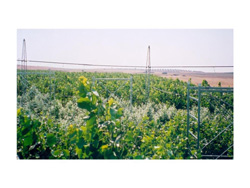Understanding how trees respond to increased CO2
While it is well known that the concentration of carbon dioxide (CO2) in the atmosphere is rising, it is not well known what effects this is going to have on ecosystems. Forests, for example, store significant amounts of carbon, but knowledge concerning possible CO2 fertilisation effects is limited. The EUROFACE project brought Free-air carbon dioxide enrichment (FACE) technology to European poplar stands. The concentration of CO2 was artificially elevated both above- and below-ground. Measurements of tree growth over a period of three growing seasons were recorded and compared against plots treated with conventional fertilisers and control plots. The data was then formatted and fed to the ANAFORE (Analysis of forest ecosystems) model by biologists with the University of Antwerp in Belgium. They found that the model was able to successfully reproduce the substantial increase in carbon sequestration not only in the leaves and branches, but also in the soil. In contrast, there were no signs of enhanced growth on the fertilised plots. While these results demonstrate the potential for increased carbon uptake by the world's largest carbon sink, forests, there was evidence of possible saturation by the third growing season. For this reason, the University of Antwerp and its EUROFACE partners advocate continued monitoring for several additional growing periods.







